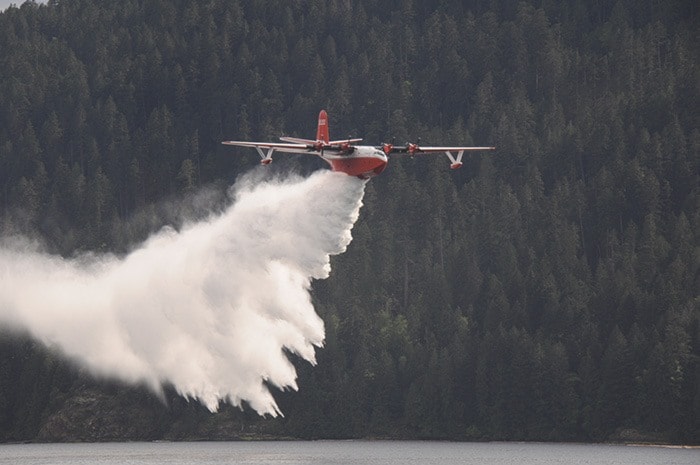The world's largest water bomber entered its last firefighting season in B.C., but Port Alberni- based owner Coulson Flying Tankers is trying to change that. In May, the ministry of forest announced this summer will be the last time they contract the Martin Mars Hawaii aircraft to fight forest fires. A government press release cited age and the difficulty it would be to fix and maintain the 1946 built aircraft as it is the last of its kind in operation.
Hawaii Mars owner Wayne Coulson of the Coulson Group of Companies, has been in contact with ministry officials and plans to meet with new forest minister, Steve Thomson, to discuss the issue. He hopes to convince the minister that the Hawaii Mars should remain as one of the many tools that could be used to fight forest fires.
"The job we do, no other airplane can do," Coulson said. "We are like a wet blanket. The province drops retardant ahead of the fire but the Martin Mars goes right on top of the fire and smothers it." The Hawaii Mars was in Powell River doing just that last week, as it helped douse a slash fire that grew to two hectares. Coulson explained the province fights fires by primarily using the indirect attack method, which is the use of air tankers dumping retardant ahead of a fire. However, the Hawaii Mars is a direct attack aircraft, which means it drops water on top of the fire. He admitted since being awarded with an annual contract since 2007, the Hawaii Mars hasn't been utilized much by the province, but that's not necessarily a bad thing.
"We are cheap insurance," Coulson said, adding that the aircraft costs $800,000 to keep around and the contract with B.C. pays for about half that amount. "Every aircraft has a place, like a tool in a toolbox." The largest direct attack aircraft the provincehas, Coulson said, is the Bell 212 helicopter, which carries up to 400 gallons (1,500 litres) of water whereas the Martin Mars carries almost 20 times more—up to 7,200 gallons (27,000 litres). He also questioned why the province relies mostly on the indirect attack method to fight fires, when places like Ontario, the United States, Australia and Greece rely primarily on direct attack. "In the U.S., 85 per cent of firefighting is done the direct attack way, only 15 per cent is retardant," Coulson explained. "Everyone everywhere else focuses on going on top of the fire." The Hawaii Mars has been called upon to fight numerous major fires outside the province, such as the 2008 Mt. Shasta fire in California, 2009 Mt. Wilson fire in California and the 2011 wildfire in Mexico. Coulson spoke highly of the work the aircraft has done in those places and how it can continue on in the future.
Forest ministry spokeswoman Vivian Thomas referred to a press release by the Wildfire Management Branch as to why the B.C. government will not continue using the Martin Mars. The release cited
that the branch intends to tender a contract for a multi-aircraft, turbine amphibious scooper that would be used on an on-call basis.
"The Coulson group can bid for this contract," Thomas said. The Hawaii Mars is a propeller plane. It directly employs 12 people and the Coulson Group employs about 250 people.
Second Mars to be retired
The retired Philippine Mars seems to also be in government limbo. The Coulson group announced three years ago that the retired aircraft was being donated to the Naval Aviation Museum in Pensacola, Florida.
The plane was even repainted its original blue last year in anticipation of retirement at the museum. However, when it will be delivered remains unknown. "It has to be signed off by the White House," Coulson said. "This is such a high profile asset and there hasn't been a trade since 1992 because of problems internally in the government." Coulson explained his group is supposed to get some ex-military assets in exchange for the Philippine Mars, but wouldn't elaborate on what it is or what it would be used for, citing it's still in negotiation. Add the fact that a Canadian company is trying to get thoseex-military assets, and even more bureaucracy ensues, Coulson said.
"I didn't know there were so many lawyers in Washington D.C. and how every government department has its own lawyers," Coulson said. "It's a work inprogress."
Coulson added he doesn't think the Philippine Mars will be leaving this year. reporter@albernivalleynews.com
